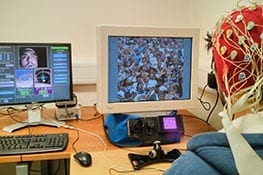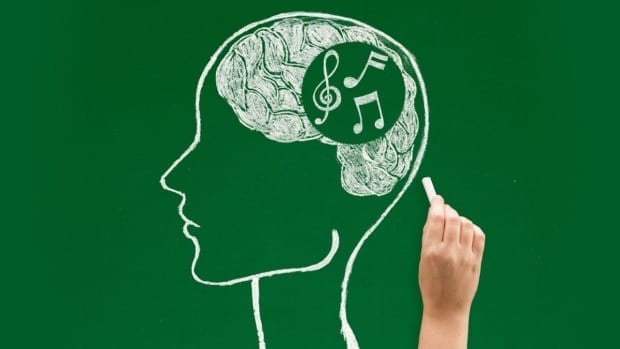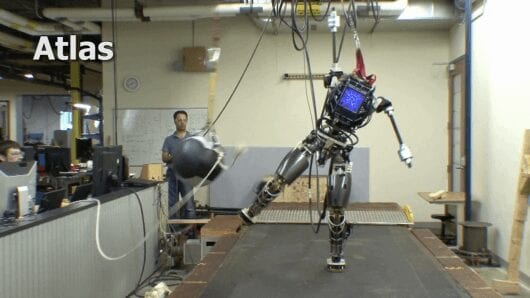
Latest advances in capturing data on brain activity and eye movement are being combined to open up a host of ‘mind reading’ possibilities for the future.
These include the potential development of a system that can detect when drivers are in danger of falling asleep at the wheel.
The research has been undertaken at the University of Leicester with funding from the Engineering and Physical Sciences Research Council (EPSRC), and in collaboration with the University of Buenos Aires in Argentina.
The breakthrough involves bringing two recent developments in the world of technology together: high-speed eye tracking that records eye movements in unprecedented detail using cutting-edge infra-red cameras*; and high-density electroencephalograph** (EEG) technology that measures electrical brain activity with millisecond precision through electrodes placed on the scalp.
The research has overcome previous technological challenges which made it difficult to monitor eye movement and brain activity simultaneously. The team has done this by developing novel signal processing techniques.
This could be the first step towards a system that combines brain and eye monitoring to automatically alert drivers who are showing signs of drowsiness. The system would be built into the vehicle and connected unobtrusively to the driver, with the EEG looking out for brain signals that only occur in the early stages of sleepiness. The eye tracker would reinforce this by looking for erratic gaze patterns symptomatic of someone starting to feel drowsy and different from those characteristic of someone driving who is constantly looking out for hazards. Fatigue has been estimated to account for around 20 per cent of traffic accidents on the UK’s motorways.***
The breakthrough achieved by the University of Leicester could also ultimately be built on to deliver many other everyday applications in the years ahead. For example:
- Computer games of the future could dispense with the need for the player to physically interact with any type of console, mouse or other hand-operated system. Instead, eye movement and brain activity data would be collected and processed to indicate what action the player wants to take. By distinguishing the tiny differences in various types of brain activity, the EEG would identify the precise action the player desires (e.g. run, jump or throw), while the eye movement data would show exactly where on the screen the player was looking when they had this thought. This information could be combined to enable the correct action to occur. An unobtrusive headset would be all that would be required to capture the necessary data.
- People who have no arm functionality could move their wheelchairs simply through their eye movements. These movements could be tracked and the corresponding brain activity analysed to identify when these indicate a desire to move in a certain direction. This would then automatically activate a steering and propulsion mechanism that would drive the wheelchair to that place.
The Latest Bing News on:
Mind reading possibilities
- Karen Read murder trial: Live updates from 7th day of testimonyon May 8, 2024 at 9:31 am
Jurors are being shown surveillance video from inside a Canton bar in the trial of Karen Read, the Massachusetts woman who is accused of striking her Boston police officer boyfriend with an SUV and ...
- Can AI read our minds? Probably not, but that doesn't mean we shouldn't be worriedon April 16, 2024 at 8:57 am
So it's unwise to rule out the possibility of AI-powered mind-reading entirely. But given the complexity of our mental lives, and how little we know about the brain—neuroscience is still in its ...
- In a future with more ‘mind reading,’ thanks to neurotech, we may need to rethink freedom of thoughton April 9, 2024 at 7:03 am
In the 1950s, Americans panicked about the possibility that advertisers would ... But as my research on neurorights argues, protecting the mind isn’t nearly as easy as protecting bodies and ...
- Scientists Concerned About Devices That Literally Read Your Mindon January 6, 2024 at 6:01 am
As the world inches ever closer to mind-reading technology ... "I think the range of reasonable possibilities includes things that are — I don’t want to say like scary enough — but like ...
- Theory Of Mind As An Emergent Property Of Generative AI Could Be A Linchpin For AI-Powered Mental Health Advisement Appson December 20, 2023 at 3:30 am
Another possibility would be for Dan to play dumb ... I am stridently not saying that there is mind-reading going on. I am merely saying that predicting or estimating what a person might be ...
The Latest Google Headlines on:
Mind reading possibilities
[google_news title=”” keyword=”mind reading possibilities” num_posts=”10″ blurb_length=”0″ show_thumb=”left”]
The Latest Bing News on:
A system that can detect when drivers are in danger of falling asleep at the wheel
- Help for Scots who fall asleep at wheelon April 27, 2024 at 4:16 pm
the risk of falling asleep at the wheel of a car was dangerous. In Germany, a study found that 24% of fatal road accidents were caused by drivers falling asleep. Civil servant Mr Alex MacMillan ...
- Police: Driver Falls Asleep, Crashes into Vehicleon April 26, 2024 at 5:00 pm
A 22-year-old motorist crashed into another vehicle Saturday after falling asleep at the ... Diego Police Department. “The driver fell asleep behind the wheel while traveling north on Howard ...
- Drink driver fell asleep at the wheelon April 20, 2024 at 5:00 pm
A man who was two times over the drink driving limit was awoken by police officers after falling asleep at the wheel. Mark Bailey was seen driving ... his journey and putting the community in danger.
- WATCH: Driver falls asleep at wheel, sends road sign flyingon April 15, 2024 at 6:16 am
FORT DODGE, Iowa (WJW) – A shocking video shows the moment a driver fell asleep at the wheel and sent a road sign flying into the air in Iowa. In a video released by the Iowa Department of ...
- WATCH: Driver falls asleep at wheel, sends road sign flyingon April 14, 2024 at 5:00 pm
FORT DODGE, Iowa (WJW) – A shocking video shows the moment a driver fell asleep at the wheel and sent a road sign flying into the air in Iowa. In a video released by the Iowa Department of ...
- EPD: Hit-and-run driver arrested for DUI after falling asleep at the wheelon April 7, 2024 at 3:00 pm
Hundreds of people gathered at the second annual Kids Fest at the YMCA. The event is to celebrate health, safety and fun. The herd lives at outdoor learning space New Village Farm. They’re ...
- Driver reported for drink driving and falling asleep on M6on November 5, 2023 at 11:29 pm
"We attended the area and gained entry to the van, only to find the driver asleep at the wheel. "He was subsequently ... those who put other motorists in danger will be dealt with robustly and ...
- Drowsy Driver Arrested After Falling Asleep Behind the Wheel on I-95on May 31, 2023 at 7:45 am
Brevard County, FL - A motorist caused a disruption on Memorial Day weekend after he fell asleep behind ... a 21-year-old driver in a state of unconsciousness behind the wheel.
- Woman arrested for drink driving after falling asleep at wheel on A64on October 5, 2022 at 7:09 am
A WOMAN has been arrested on suspicion of drink driving after she was reported to police for falling asleep behind the wheel. While on patrol on Monday evening (October 3) a North Yorkshire ...
- Driver fell asleep at the wheel on A229 killing own motheron July 27, 2021 at 7:20 am
She was charged with causing death by dangerous driving and ... “As seen by this tragic case, falling asleep at the wheel can be devastating for the driver, any passengers and other road users.
The Latest Google Headlines on:
A system that can detect when drivers are in danger of falling asleep at the wheel
[google_news title=”” keyword=”a system that can detect when drivers are in danger of falling asleep at the wheel” num_posts=”10″ blurb_length=”0″ show_thumb=”left”]











